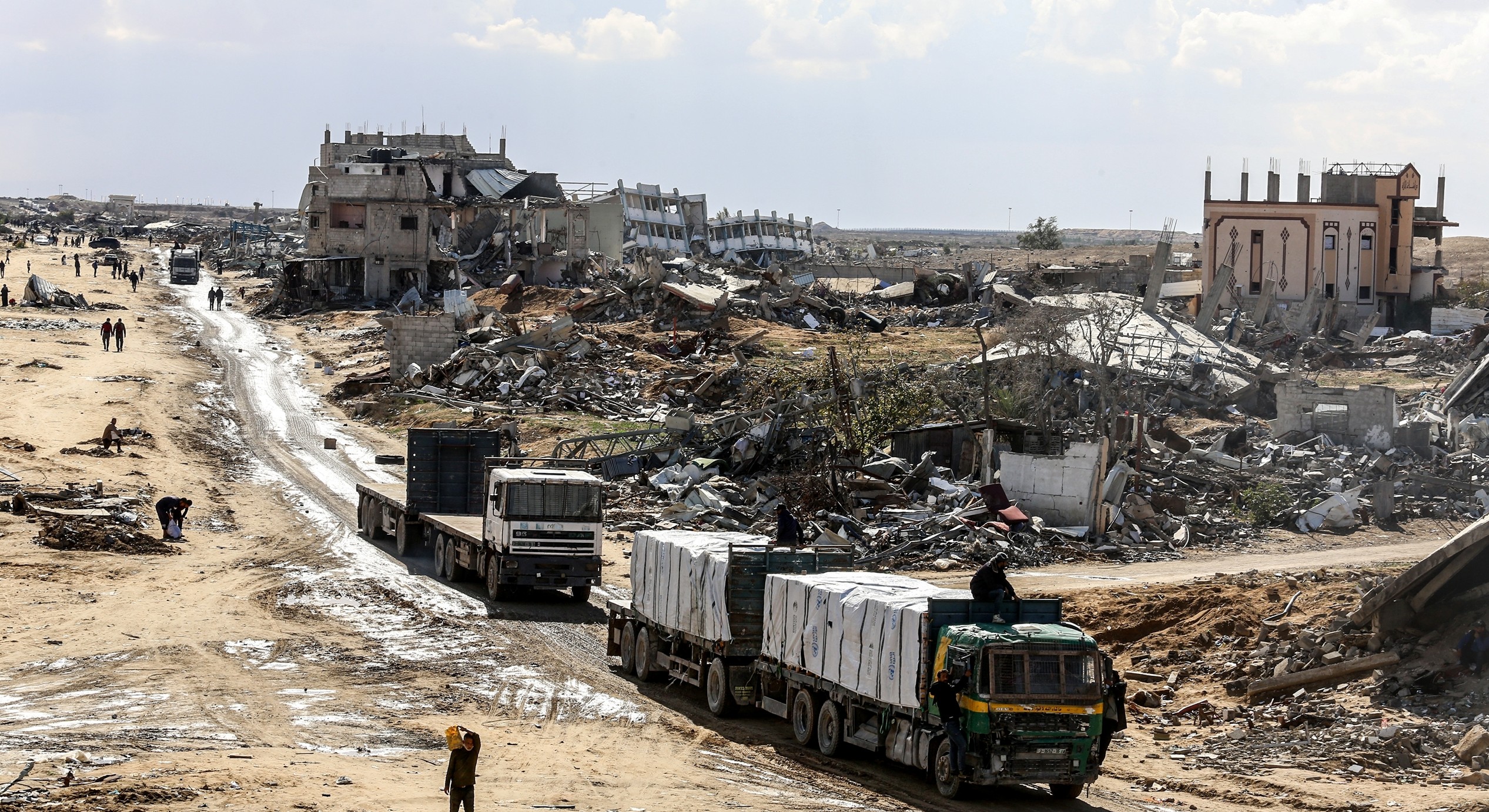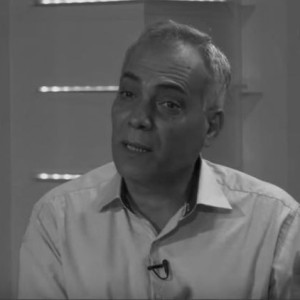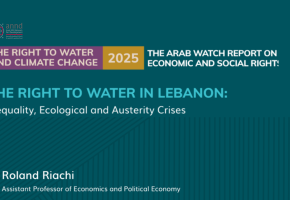
The Humanitarian Suffering in Gaza Continues Despite the Alleged Ceasefire - Tayseer Mhaisen
Tayseer Muhaisen

The Humanitarian Suffering in Gaza Continues
Despite the Alleged Ceasefire - Taysir Mhaisen
While writing
this article, tens of thousands of displaced persons in the southern Gaza Strip
were sleeping on the ground outside, waiting to be allowed to pass through
Al-Rasheed and Salah Al-Din Streets to their homes in the north. It seems that
Israel is evading, as usual, using flimsy excuses to neglect its obligations
under the prisoner exchange agreement. It was striking that an agreement was
concluded that allows the return of the displaced to destroyed areas without
infrastructure, a service system, or sufficient housing, in addition to the
lack of security and safety (due to epidemics, rabid animals, rubble, thieves,
and food shortages). To complete the bleakness of the humanitarian and
political scene, the US President made dangerous statements about cleansing
Gaza of its residents.
After about 15
months, the Palestinians of the Gaza Strip (about 70% of whom are refugees)
have a new experience of displacement, suffering, loss, and hunger. Despite the
ceasefire, grief and uncertainty continue. The intensity and brutality of the
aggression have worsened continuously. As a result, the situation of the
displaced has aggravated in an area that is less than a quarter of the size of
the Strip (a coastal strip from Az-Zawaida to the north of Rafah, which the
occupation calls a “humanitarian zone”).
The
unprecedented aggression has made Gaza uninhabitable. The intensive bombing and
military operations destroyed entire neighborhoods and vital infrastructure.
The number of victims has risen to tens of thousands, including a large
percentage of women and children. The war has destroyed livelihoods, uprooted
families, shattered governance and life management systems, and exacerbated the
already deteriorating humanitarian situation.
Nowhere is safe
in the Strip, and reconstruction is not imminent. The lives of the displaced,
returnees, and residents will continue to suffer. The methods of controlling
the entry and distribution of aid are increasing, humanitarian crises are
worsening (food security, multidimensional poverty, energy, health, education,
and environment), and social cohesion and the banking industry are being
damaged (cash liquidity crisis). This situation creates a repellent climate
that encourages migration in a war that aims to destroy awareness and
dispossess people.
It is painful
that the return of the displaced is not a solution to all the aforementioned
crises, as the destruction of systems and infrastructures and the remains of
tons of explosives make the return unsafe and inauspicious.
With more than
1.9 million people displaced and forced to seek refuge in overcrowded shelters
lacking necessities, thousands of women, children, people with disabilities,
the elderly, and others of all ages and backgrounds faced significant
psychological, social, and livelihood challenges in a complex, stressful and
dangerous environment. They lost their familiarity, security, and stability,
and social and human ties were severed or damaged. In the face of all these
challenges, many adaptation strategies have been identified, whether initiated
by the displaced themselves or encouraged by humanitarian agencies and local
and international NGOs.
These
adaptation strategies include improving shelter infrastructure, seeking food
aid, flourishing the “stalls” trade and market activities in general, using
clay ovens for baking, and managing small and micro projects based on existing
skills, experience, and available opportunities (primitive barbershops in a
hut, making pastries, using solar panels to charge batteries and mobile phones,
managing a small café on the beach, etc.), running alternative education
initiatives, swimming almost daily as a form of bathing and recreation,
spending long periods in cafés or internet shops and communicating with the
outside world, activating traditions and customs to resolve disputes between
the displaced or between them and the host community, implementing distraction,
entertainment and sports initiatives, especially with children, forming
community protection committees, organizing psychological support sessions, and
so on.
The UNRWA Problem
The United
Nations Relief and Works Agency for Palestine Refugees (UNRWA) was subjected to
various types of harassment during the aggression. Its headquarters and
vehicles were bombed, several of its employees were killed and wounded, its
funding was reduced, and its representatives were restricted from entering the
occupied Palestinian territories. Today, it continues to be persecuted through
the implementation of US legislation that banned its funding and also through
the implementation of the decision passed in the Israeli Knesset, which is
expected to come into effect on January 28.
Among the
direct results of the above is the dismissal of about 13,000 UNRWA employees
from the Gaza Strip, the collapse of humanitarian activities even if some
international relief organizations were to replace it with some essential
functions (keeping 47,000 children out of school, and depriving more than half
a million refugees of medical services). In addition to the derogation of
international legitimacy resolutions regarding the rights of Palestinian
refugees, it is feared that Israel will exploit the matter to impose "de
facto formulas" to manage the sector the next day. While the
Secretary-General of the United Nations commented by saying that "there is
no alternative to the agency," one Israeli legislator considered it part
of the problem, not part of the solution!
On Aid
Given that the
Palestinian-Israeli conflict has been going on for decades, the consequences of
the recent war, from a humanitarian and human rights perspective, will be
severe, immediate, and cumulative. The experience of the population of the Gaza
Strip has involved direct suffering as a result of attacks, deprivation, and
displacement, and further indirect suffering due to the cumulative
deterioration of essential services, life opportunities, and livelihoods.
Therefore, protection, assistance, and a minimum level of dignity have been
priorities for humanitarian action.
The Gaza Strip
is among the most densely populated areas in the world, where approximately 2.3
million Palestinians live in an area of 365 square kilometers. Throughout
this time, the Strip has suffered from structural crises, and 80% of its
population has relied on external aid amid widespread poverty and unemployment,
the deterioration and collapse of civil and political institutions, food
insecurity, the deterioration of the local environment, and reduced access to
the most basic rights and services.
During the
aggression, relevant issues emerged regarding aid, including control,
politicization, and militarization (from banning to imposing restrictions to
controlling types and quantities and targeting security personnel, warehouses,
and trucks) and making it a tool for pressure and blackmail. Despite the
ceasefire, hundreds of tons of aid remain stuck at border crossings.
The United
Nations has acknowledged that distributing aid in Gaza is a “major challenge.”
The UN Secretary-General has stated that the way Israel is conducting its
offensive is hampering the delivery of aid. A joint statement by UNICEF, the
World Health Organization, and the World Food Program (WFP) stated that the
limited amount of aid reaching Gaza has failed to prevent “the deadly
combination of hunger, malnutrition, and disease.”
While the world
remains silent, Netanyahu boasts. “We are providing the minimum humanitarian
aid, [...] if we are to achieve our war aims!” he declared. No wonder, as
two-thirds of Israeli Jews oppose the entry of aid into Gaza.
In conclusion,
it is worth saying that what has hurt us most in this war is the confusion of
meanings and the dismantling of systems (returning things, people, and
relationships to a time before the family, the state, civil society, and the
systems of modern civil life). While the gap between reality (the field) and
illusion (the delusions spread by cyberspace) is widening day by day, the
people of the sector feel that not only has everyone ignored their suffering,
but each of them is trying to exploit it to serve individual purposes and
goals.
Recent publications

